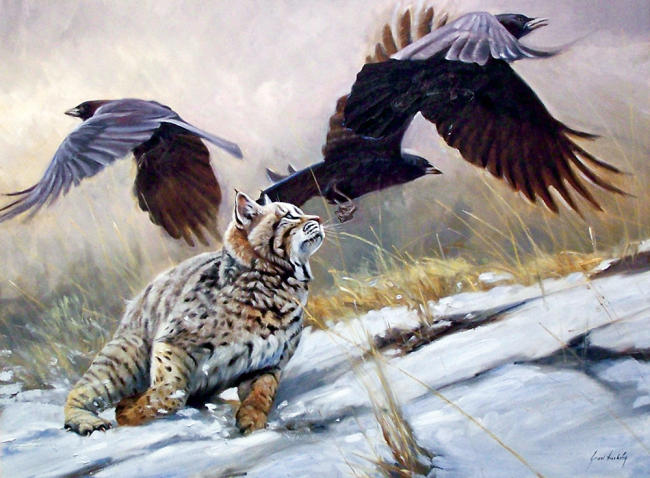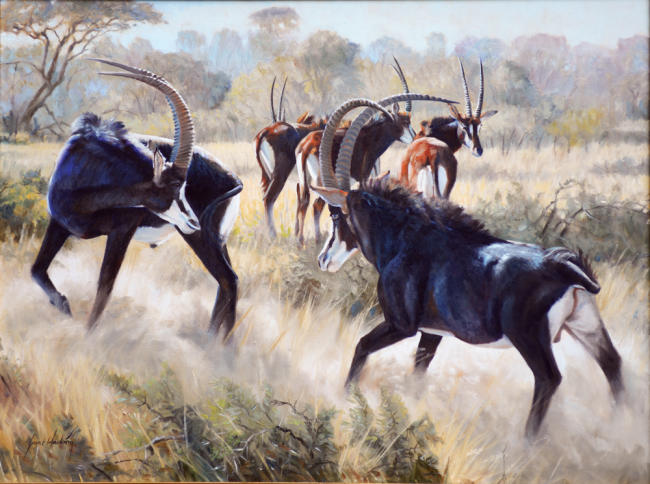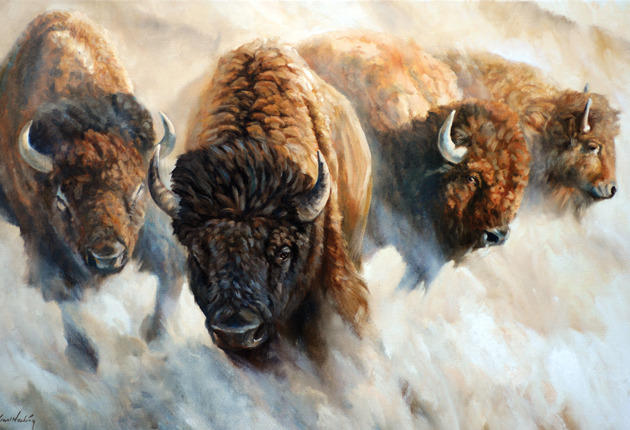From the January/February 2015 issue of Sporting Classics.
Plunging into the pure visual serenity of a New England autumn, Grant Hacking looks toward the expanding horizon of his career. He talks aloud about his desire to paint more megafauna in the American West, to challenge himself with explorations of new landscapes, and to steal away just one more day in the sugar-maple hardwoods before the burning colors dissolve away.
Time, Hacking sometimes feels, is fleeting. Wherever he goes, it’s the diaphanous half-light that flows through his work—the kind of impermanent ether you see only momentarily at the entrances and exits of dreams.
Hacking has spent half his life building a reputation as a keen interpreter of nature, best known for his depictions of big-game animals and birds. The visual language he communicates, however, was imprinted upon him in another place and time, though it’s universally recognizable to those who carry rod and reel or trigger and barrel. The origins reside far away from America and today seem like reverie.

When Hacking sits down with his two daughters and tries to explain how his childhood differed from theirs, the challenges of translating memories from southern Africa invariably turn on a question: “Well, girls, where do I begin?”
Should the stories commence with the day that a fickle black mamba nearly bit Hacking and his brother or the night the tickle of scorpions crawling across his sheets woke him, or the time a camel chased him? Or perhaps—reaching back to the middle of one night in Zimbabwe—the tale of his mother, who believed she was hounding the neighbor’s scavenging dog out of the kitchen and into a makeshift backyard carved out of the bush? While standing alone in pitched blackness and wielding only a frying pan, she realized the nocturnal trespasser was actually a leopard.
The White Mountains of New Hampshire, which he now calls home, are alluring. But wildness on a whole different level once lived larger and closer to Hacking and through the power of memory is never difficult to summon.
“When I was growing up in South Africa and Zimbabwe,” he says, “dinnertime in our house was not only about wolfing down my mother’s beautifully prepared meals but coming together to reflect on and recount the experiences of the day—moments that often involved encounters with wild creatures.
“To make them more vivid, we verbally drew pictures for each other. This instilled in me a sincere compulsion to communicate and share my world more permanently. And it’s one of the reasons why I became a painter.”
Hacking today is in his prime as a wildlife and landscape artist. Positive critical attention only affirms what his collectors have long known.
He’s been juried regularly into the Leigh Yawkey Woodson Art Museum’s prestigious “Birds in Art” exhibition. He donated a smaller-format tiger painting to the Palm Beach Zoo that raised $20,000. Maybe most importantly, he is respected by those who have the means to buy works by any contemporary artist they choose—collectors such as Tom James, for example.
The executive chairman of Raymond James Financial, Tom and his wife, Mary, have amassed a remarkable and unprecedented collection of Western and wildlife art—2,500 pieces half composed of Western and 25 percent composed of wildlife art from the best living artists of the last quarter century.
“It is a profound honor to be included on the list of painters whose artwork Tom James collects,” Hacking says.
James first became aware of the artist through Hacking’s African portfolio. He invited Hacking down to St. Petersburg, Florida, where he and his wife staged art shows, and over the years he’s acquired more than 30 of the Hacking’s works.
“When I like the artists as people, I like their work better,” James says. “That doesn’t mean they can’t be a little quirky. Many of them are. Grant is a gentleman, but his painting stands on its own.”

As a transplant in America who is smitten with its towering mountains, Hacking has demonstrated an impressive proclivity for depicting the species on this continent.
“Switching from African paintings to North American paintings can be quite challenging,” he says. “The differences in my pallet and even the way I apply the paint are things that I need to be conscious of. If I paint a lot of North American scenes, I start to miss the African work and vice versa.”
A winner of multiple art-show awards, Hacking’s paintings also have been featured on the covers of numerous magazines. What he conveys is the ineffable quality of being outdoors that hunters know better than most—be it the light carried on the horizon or the soft shadows that drape a valley at dawn or dusk. There’s something soothing and magnetic about his work.
In Chilly Morning, Hacking portrays a mule deer buck in the broken scrublands of the West during the height of the rut. It’s not just the anatomical precision of the animal that he’s after but the creation of mood.
“I am always thrilled by the way the light catches the mountaintops on those chilly October mornings,” he says. “Hunters who rise early know the alpenglow.”
With Afternoon Shadows, he celebrates a muse, the American pronghorn, which remind him of the diverse array of antelope he encountered in his youth. “On long road trips between Montana and Utah, it’s so enjoyable to catch sight of pronghorns crossing the plains of light and shade as the sun starts to make its way toward the horizon,” he says.
To stay connected to Africa, Hacking returns fairly often. The changes that have been wrought are both inspiring (the racial separateness that he knew is gone) and agonizing (the protective gauntlet that once enwrapped wildlife is steadily vanishing).
He wonders how his daughters will view Africa in the middle of this century when they reach his current age. His response is to paint, to arouse a response in viewers, and to proclaim that the essence of African animals cannot be realized in a zoo. It’s all about place and the evolutionary forces that made them.
After going through a quiet, reflective period in his career, Hacking, who just turned 50, is back with a newfound strength and maturity. For him, it’s all about perspective: knowing what’s important in life and focusing on those essentials is no different from decisions a painter makes.
When he paints landscapes, it’s as if he’s rubbed the dust of time into his brush tips. Color is tempered, not loud, and what you appreciate is composition.
With avian subjects, Hacking excels. In Triumphant Strike, a grouse has been taken by a red-tailed hawk. The avian encounter is as evocative as works from Bruno Liljefors or Louis Agassiz Fuertes and incorporates the same shading and earthy tones that the period artists of the 18th and 19th centuries used in their works—styles that he has studied first-hand.
“Whenever I visit my family in England I make a point, as a student of history, to visit at least one of the many castles and manors In addition to the fascinating stories of the estates, there are often old paintings,” Hacking says. “I especially love the old hunting and game scenes.”
Hacking came of age when the region of southern Africa was producing some excellent wildlife artists who painted in the European tradition. They hailed from Zimbabwe, South Africa, and Kenya and were joined by talented contemporaries from North America and England and included Bob Kuhn, Robert Bateman, Ken Bunn, and David Shepherd.
Hacking had artist parents who also savored the outback, feeding their kids wild game and encouraging them to explore.
“My mom and dad actually met in art school. My father was a painter of the African bush and local landscape scenes,” he says. “Being around people who were buying art probably was the single greatest influence on my career. As a youngster I visited every David Shepherd exhibition and was captivated by his paintings.”
On family outings, driving along two-track routes that paralleled game trails, Hacking often sat on the hood of the vehicle and scouted for wildlife. In those days there were still prodigious numbers of elephant, rhino, and buffalo.
“When I was young I remember sitting at the Great Zimbabwe ruins and listening to the lions roar as the mist drifted through the ruins. That was real Africa and it fired my imagination,” Hacking says.
A few years later he served in the South African army and was assigned to the country’s war museum restoring and preserving artworks completed during World War II. He received a crash course in the nuances of abstract, with brushwork that focuses more on conveying a mood rather than every bit of detail, a technique now evident in his own work.
Many of the paintings that flow out of his studio are landscapes with African creatures that give the works their sense of spatial scale. Take, for instance, his painting of indigenous Nguni cattle. The animals were originally brought to South Africa centuries ago when the Zulu, Xhosa, and Swazi tribes migrated south, Hacking explains.
After European colonists arrived, the semi-wild bovines were ignored in favor of imported breeds, which didn’t fare as well amid the harsh climate and diseases that strike domesticated animals.
In recent years, Ngunis have made a comeback and in post-apartheid South Africa, they’ve proved popular. In America, Western art celebrating cattle and cowboys is de rigueur. Hacking’s painting speaks to an African version.
“To me, the Nguni story reflects a lot about what’s going on in South Africa,” Hacking says. “Standing among these majestic ancestral cattle with huge flocks of cattle egret feeding around them was the highlight of my trip.”
Another notable sojourn, he adds, involved a trip into broken terrain high above the Orange River to see ancient cave drawings made by San artists thousands of years ago. He wonders if they had the same kind of creative impulses watching animals move across the landscape below.
Hacking says wildlife art needs no defense, certainly none against the many urban dwellers who disparage it as prosaic and whose own understanding of the natural world is lacking.
“There are artists painting wildlife right now who are every bit as talented and skilled as someone doing figurative work or landscape or what passes as abstract expressionism,” he says.
Grant Hacking has touched wildness wilder than most artists will ever know. For him, it isn’t merely a dream. Africa was a dream he lived, and he’s filled with a feeling that never goes away. +++
Columnist Todd Wilkinson, who grew up hunting and fishing in the North Woods of Minnesota, lives in Montana and is a noted authority on wildlife and sporting art. He also is author of a new critically-acclaimed book Last Stand: Ted Turner’s Quest to Save a Troubled Planet.
Be sure to subscribe to Sporting Classics to read Wilkinson’s next sporting-art column.

